Thinning intensity affects microbial functional diversity and enzymatic activities associated with litter decomposition in a Chinese fir plantation
Wenya Xiao•Fei Fei•Jiaojiao Diao•Bin J.W.Chen•Qingwei Guan
Abstract Microbial functional diversity and enzymatic activities are critical to maintaining material circulation during litterde composition in forests.Thinning,an important and widely used silvicultural treatment,changes the microclimate and promotes forest renewal.However,how thinning affects microbial functional diversity and enzymatic activities during litter decomposition remains poorly understood.We conducted thinning treatments in a Chinese fir plantation in a subtropical region of China with four levels of tree stem removal(0,30,50,and 70%),each with three replicates,and the effects of thinning on microbial functional diversity and enzymatic activities were studied 7 years after treatment by collecting litter samples four times over a 1-year period.Microbial functional diversity and enzymatic activities were analyzed using Biolog Ecoplates(Biolog Inc.,Hayward,CA,USA)based on the utilization of 31 carbon substrates.Total microbial abundance during litter decomposition was lower after the thinning treatments than without thinning.Microbial functional diversity did not differ significantly during litter decomposition,but the types of microbial carbon-source utilization did differ significantly with the thinning treatments.Microbial cellulase and invertase activities during litter decomposition were significantly higher under the thinning treatments due to changes in the litter carbon concentration and the ratios of carbon and lignin to nitrogen.The present study demonstrated the important influence of thinning on microbial activities during litter decomposition.Moderate-intensity thinning may maximize vegetation diversity and,in turn,increase the available substrate sources for microbial organisms in litter and promote nutrient cycling in forest ecosystems.
Keywords Biology technology·Litter decomposition·Microbial enzymatic activities·Shannon diversity index
Introduction
Disturbances in forests are common in natural systems,altering microclimate and litter inputs to the forest floor,thus affecting microbial diversity and enzymatic activities associated with litter decomposition(Wang et al.2010;Rietl and Jackson 2012).Reductions in soil microbial abundance and activities and shifts in the functional composition of microbial communities have been reported following disturbances,and the extent of changes is related to the disturbance(Berga et al.2012;Holden et al.2013).However,the response of microbial communities to disturbances is far from fully understood.How microbial diversity and function are related to each other also remains unclear(Andersen et al.2013).
Thinning,an important silvicultural treatment to maintain or improve stand productivity in plantations worldwide,decreases litter fall,affects litter decomposition,and increases nutrient mobilization due to the changes in understory light availability and microclimate caused by partial canopy removal(Roig et al.2005;Rietl and Jackson 2012).Previous studies have shown that microbial biomass decreases following thinning,whereas microbial activities increase,leading to an increase in litter decomposition(Smolander et al.2008;Wang et al.2010).
However,other authors have reported that microbial biomass and extracellular enzyme activities involved in litter decomposition decrease after thinning and with the intensity of harvesting,due to changes in the proportions of fungi and bacteria(Hassett and Zak 2005;Geng et al.2012;Adamczyk et al.2014,2015).To date,few studies have focused on microbial functional diversity and enzymatic activities associated with thinning during litter decomposition(Chen et al.2015,2016).Furthermore,few studies have used different thinning intensities to study microbial functional communities in litter.
Litter decomposition is governed by the microbial activity and,especially,the diversity of fungi(Trinder et al.2009;Mukhopadhyay and Joy 2010;Fanin et al.2011;Krashevska et al.2012).Studies of litter microbial abundance,functional diversity,and enzymatic activities are necessary because functionally dissimilar species perform diverse decomposition functions(Bardgett et al.2001;Bray et al.2012;Zhang et al.2013).Reductions of microbial biomass do not always decrease litter decomposition rates,which also depend on shifts in microbial community structure(Bundschuh et al.2011;Artigas et al.2012;Fernandez et al.2015).Microbial functional communities affect and are affected by the quality of organic matter and litter chemistry(Cleveland et al.2014;Creamer et al.2015).
The composition and quality of litter determine the biophysical habitat,carbon forms,and the input for energy,thereby influencing microbial activity and respiration during litter decomposition(Fanin et al.2011;Bray et al.2012;Zhang et al.2013;Wang et al.2014).Furthermore,litter chemistry and characteristics are strong determinants of microbial enzyme activity in decomposing litter.Thus,understanding the changes in microbes that occur in response to environmental and structural changes in ecosystems could provide valuable insights into ecosystem functions(Griffiths et al.2001;Kourtev et al.2002;Baldrian et al.2012).
This study examines how thinning intensities affect microbial functional diversity and enzymatic activities over time during litter decomposition and how such changes influence the functionality of microbial communities via variations in litter chemistry.We assessed(1)how different thinning intensities(30,50,and 70%stem-only thinning)versusno thinning influenced microbial abundance and functional diversity and(2)how microbial enzymatic activities associated with litter decomposition respond to thinning intensity.
We hypothesized that microbial abundance and functional diversity would increase with the thinning intensity due to increases in the concentration of chemicals in litter.In addition,we predicted that a high thinning intensity would promote microbial enzymatic activity because both the content of available chemicals in the litter and microbial diversity would increase with the thinning intensity.
Materials and methods
Study area and plant materials
Chinese fir(Cunninghamia lanceolata[Lamb.]Hook)is an important native evergreen conifer that has been extensively cultivated for several thousands of years in southeast China(Dong et al.2015).The total plantation area of Chinese fir now covers approximately 9.21 million ha,representing more than 18 and 5%of the forest plantations in China and worldwide,respectively(Huang et al.2012).
This study was conducted in a 26-year-old Chinese fir plantation at the Lishui Tree Farm Research Station(119°01′E,31°36′N)of Nanjing Forestry University in Jiangsu,China.The site is located at an altitude of 100 m and has a slope of 15°,with a southern orientation.The type of soil is Haplic Luvisol(Food and Agriculture Organization of the United Nations 2006),and the soil is generally less than 30 cm deep.
The climate of the study area is subtropical,with a mean annual temperature of 15.5°C,a mean annual sunshine duration of 2146 h,mean annual precipitation of 1005.7 mm,and a mean frost-free period of 220 days per year.The average monthly humidity and temperature at the study site during the sampling period are shown in Fig.S1.
Experimental design
Twelve study plots(20 m×20 m,with an over-story dominated by Chinese fir)were established in a completely randomized design with three replicates for each of the four treatments.Thinning was performed from February to April 2006.The treatments included:(1)CK:control(no tree removal);(2)LIT:low-intensity thinning(30%of trees removed);(3)MIT:medium-intensity thinning(50%of trees removed);and(4)HIT:high-intensity thinning(70%of trees removed).
To reduce potential edge effects,each plot was surrounded by a 5 m-wide buffer zone.In the thinning process,individual Chinese fir trees that possessed a good external stem quality were retained,and an even distribution of the remaining trees was produced.All the wood material thinned from the selected trees was removed from the plots and used for commercial lumber production.Seven years after thinning(in October 2012),stand density averaged 1020±53(mean±1 s.e.m.)trees ha-1in HIT,1547±39 trees ha-1in MIT,and 2073±34 trees ha-1in LIT,whereas the control plots contained 3049±22 trees ha-1(Table S1).Thinning also altered the mean tree height(m),diameter at breast height(DBH,cm),girth of trees(G,cm)and understory plant species composition(Tables S1–S3).
Litter collection
We collectedC.lanceolataleaves by hand from the forest floor in each of the twelve plots in December 2012.The litter was freshly fallen and fully intact.All litter was ovendried to a constant weight for 24 h at 85°C.A portion of each litter sample was used for biochemical analysis,and a portion was used for the decomposition experiment.
We employed the litter bag method for the decomposition experiment.The litter bags were sewn from heavy duty nylon mesh(1 mm)and had dimensions of approximately 15 cm×25 cm.A 12 gm sample of dried C.lanceolataleaves was placed in each bag.Then,50 bags of litter from each original plot were randomly placed on the forest floor in the corresponding plots and covered with in situ litter on December 31,2012.A total of 600 l bags were placed in the 12 plots.Finally,three replicate litter bags from each plot were harvested on March 31,2013(90 days later),June 29,2013(180 days later),September 30,2013(273 days later),and December 30,2013(364 days later).
Biochemical analyses
After incubation,the litter bag samples were oven-dried to a constant weight for 24 h at 85°C and then crushed for preparation.The concentrations of lignin and cellulose in the litter samples were estimated via gravimetry,using hot sulfuric acid digestion(Wardle 2002).The total carbon(C)and nitrogen(N)contents of the litter were measured via dry combustion and thermal conductivity detection using a C/N-analyzer(Vario EL III,Elementar,Germany).We cultured microbial total abundance(TA)using a dilution plate method.A sub-sample of 5 g(fresh weight)of litter was homogenized with 45 ml of sterilized distilled water in a blender for 30 s,followed by filtration through a 1-mm nylon mesh to obtain a suspension.Next,a series of dilutions was prepared.Finally,1-ml of a 1:10,000 dilution was mixed with 20 ml of Martin medium,beef-protein medium,and Gause’s Synthetic Agar Medium in each of five Petri dishes.The plates were incubated for 1 week at 20°C in darkness and examined.Separate litter samples were dried(85°C,24 h)to determine water content and convert fresh weight to dry weight.We calculated the abundance of microorganisms as the number of colony forming units in 1 g of dry litter(Zhang et al.2008).
Microbial functional diversity was analyzed using Biolog Ecoplates(Biolog Inc.,Hayward,CA,USA)based on the utilization of 31 carbon substrates.Each sample(10 g of fresh litter)was extracted with sterile 0.85%NaCl by shaking for 10 min at 25°C.One thousand-fold dilutions were performed after the suspensions settled for 15 min.The plates were inoculated with 125-μl aliquots using a multichannel repetitive dispensing pipette.The color development of the wells at 590 nm was read,using an automated Biolog Microplate TM Reader(Biolog Inc.,Hayward,CA,USA).For each litters ample,three replicates were prepared.The plates were then incubated at25°C in darkness and read every 24 h over a period of 10 days.The average well color development(AWCD)was calculated according to Garland(1996).The absorbance(absorbance unit,g-1litter)measured after 168 h was used to calculate its functional diversity.We calculated functional diversity using the Shannon diversity index(H′)and Pielou’s evenness index(J′).We used- Σpilnpito calculateH′,wherepiis the ratio of activities on each substrate to the sum of activities on all substrates.AndcalculatedJ′asH′/lnS,whereSis the number of carbon sources that can be used by microorganisms(Zhang et al.2012).
Dehydrogenase activity was measured based on the reduction of triphenyl tetrazolium chloride to triphenyl formazan(Wu et al.2004).Peroxidase and urease activities were measured spectrophotometrically,using L-3,4-dihydroxyphenylalanine(DOPA)and urea as a substrate(Saiya-Cork et al.2002).Invertase and cellulase activities were determined using a substrate consisting of carboxymethylcellulose and sucrose(Schinner and von Mersi 1990;Deng and Tabatabai 1994).Acid phosphatase activity was determined based on the concentration of p-nitrophenol with pNP-linked substrates(Geng et al.2012).
Data analysis

We examined the changes in litter total C,total N,lignin and cellulose concentrations,C/N,lignin/N,microbial functional diversity indices and enzymatic activities associated with the thinning treatments and sampling date using the following model:whereYijkis the dependent variable of interest;Ti(i=1,2,3,4)is the thinning treatment;Dj(k)(j=1,2,3,4)is sampling date;and πkis the random plot effect(k=1,2,…12).We conducted the mixed effect analysis using maximum likelihood with thelme4package(Bates et al.2016).The Shapiro–Wilk test indicated that the assumption of normality was not met at α=0.05 for several models.We therefore performed the parameter estimates via 1000 iterations.To examine the influence of the thinning intensity and sampling date on the microbial community composition,we used permutational multivariate analysis of variance(ANOVA).To illustrate how the microbial community composition was affected by the thinning intensity and sampling date,we conducted nonmetric multidimensional scaling(NMS)analysis.A Pearson correlation analysis was performed to determine which environmental variables best explained the changes in the microbial community composition.These analyses were performed,using R version 3.3.1.
Results
Chemical concentrations during litter decomposition
The chemical characteristics of the decomposing litter differed with the day of decomposition and thinning intensity(Fig.1,Table S3).A significant increase of the total nitrogen(N)concentration in decomposing litter was observed with an increasing thinning intensity(P<0.05)(Table S3).The effects on the total carbon(C),lignin,and cellulose concentrations and the lignin/N and C/N ratios in litter were associated with the sampling date,and these variables were not strongly influenced by thinning.
The N concentration decreased with an increasing thinning intensity at90 days of decomposition but increased with an increasing thinning intensity at 180 days.However,the C concentration gradually stabilized with the decomposition of the litter.Compared with the control,the high thinning intensity significantly decreased the cellulose concentration and increased the lignin concentration in the litter at 273 days(P<0.05).A similar decomposition trend was observed among all treatments for the C/N ratio and lignin/N ratio;C/N was highest after decomposition for 90 days,and lignin/N was highest after 364 days(Fig.1).
Total abundance of the microbial community during litter decomposition
The total microbial abundance decreased on average with the thinning intensity and sampling date,with a significant interaction effect of the two factors being detected for total microbial biomass(P<0.05)(Table 1,Fig.2).The large difference in total microbial biomass between different thinning intensities observed at 90 days diminished after 180 and 273 days,but the thinning effect returned at 364 days.
Microbial functional diversity
The average well color development(AWCD),Shannon diversity index(H′)and Pielou’s evenness index(J′)did not differ with the thinning intensity but did differ significantly with the sampling date(P<0.05)(Table 1,Fig.3).The effects of thinning onJ′were less apparent on the other sampling dates,although at 273 days,J′was significantly lower under medium-intensity thinning than under the other treatments(Fig.3).
Although the microbial functional-diversity index showed no significant response to the thinning intensity,the types of microbial carbon sources varied significantly under different thinning intensities.The different carbon sources that were associated with a high Pearson correlation coefficient(>0.6)within PC1 are listed,and these results indicated that the differences between thinning intensities might have been primarily associated with increases in the utilization of specific carbohydrates and amino acids at 90 and 273 days;specific carbohydrates,carboxylic acids,amino acids and polymers at 180 days;or specific carbohydrates and polymers at 364 days(Table 2).In the early stage of decomposition(90 and 180 days),the microbial utilization of carbon sources did not differ significantly,but a significant distinction was observed at 273 and 364 days(Fig.4).
Nonmetric multidimensional scaling(NMDS)—indicated that the microbial utilization of carbon sources was significantly different between the thinned plots and control plots;there were also clear distinctions between medium-intensity thinning and low-and high-intensity thinning at 273 days.However,the difference between thinning intensities was not significant at 364 days(Fig.4).
Microbial enzymatic activities
Peroxidase,urease,and acid phosphatase activities only varied significantly with the sampling date(P<0.01),while cellulase and invertase activities were significantly affected by the thinning intensity and decomposition(P<0.01).However,no difference in dehydrogenase activity was observed among the treatments(Table 1).The thinning treatments increased cellulase activity at 90 and 364 days of litter decomposition,by 84.73 and 68.29%under high-intensity and medium-intensity thinning,respectively.Invertase activity was increased at 90,180and 364 days,but decreased at 273 days during decomposition.Invertase activity was significantly increased by 227.27,381.82,and 635.06%in the low-,medium-and high-intensity thinning treatments,respectively,after 90 days of decomposition(P<0.01)(Fig.5).Under the thinning treatments,peroxidase,urease,and acid phosphatase activities increased with litter decomposition,whereas cellulase and invertase activities were decreased(Fig.5).

Fig.1 Chemical properties of the litter(concentrations,%)under different thinning intensities(CK,control plots;LIT,low-intensity thinning;MIT,medium-intensity thinning;HIT,high-intensity thinning)during litter decomposition.Values are means±95%bootstrapped confidence intervals
Correlation analysis of microbial functional diversity and enzymatic activities during litter decomposition with the chemical characteristics of litter
According to the correlation analysis,the correlation between the microbial functional diversity indexes and temperature and humidity was relatively significant.Microbial total abundance was significantly and positively correlated with total carbon and the C/N ratio(P<0.01)but negatively correlated with temperature(P<0.01)(Table 3).
Peroxidase,urease,and acid phosphatase activities were significantly and negatively correlated with litter total carbon(P<0.01),the C/N ratio(P<0.01)and microbial abundance(P<0.05).Furthermore,urease activity was negatively correlated with the total nitrogen content of the litter(P<0.01).In addition,cellulase and invertase activities were positively correlated with litter carbon and the C/N ratio(P<0.01)but negatively correlated with temperature and the lignin/N ratio(P<0.05)(Table 3).
Discussion
The results showed that the functional diversity of the microbial community during litter decomposition did not vary significantly under the different thinning treatments,but the type of microbial carbon sources utilized did vary between these treatments.Total microbial abundance was lower under the thinning treatments than the controltreatment during litter decomposition,which is inconsistent with our hypothesis.Cellulase and invertase activities were significantly increased by different thinning intensities and were also positively correlated with the C concentration and the C/N ratio in litter.By analyzing the abundance,diversity,and enzymatic activities of the microbial community during 1 year of decomposition,we achieved an improved understanding of the responses of microorganisms to different thinning treatments during litter decomposition.
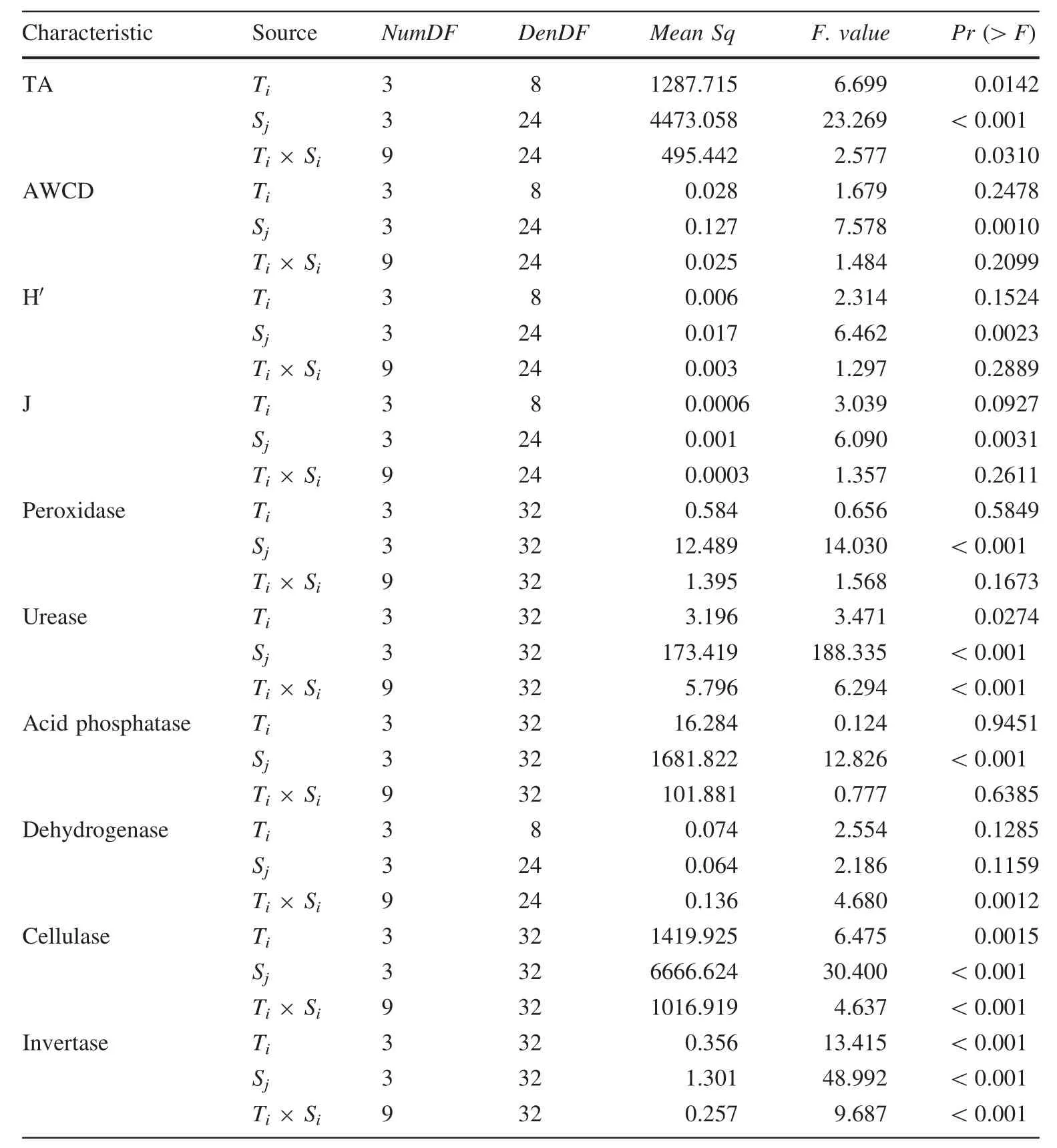
Table 1 Effects of the thinning intensity(Ti=1,2,3,4)and decomposition days(Sj=1,2,3,4)on litter microbial community
Microbial functional diversity
Previous studies have shown that microbial biomass increases following thinning treatment in the black pine forest,which has been attributed to temperature and organic C(Bolat 2013).In the present study,which focused on the microorganisms present in litter,decreases in microbial abundance were observed with thinning.This finding might be explained as follows.Due to alterations in the canopy,the thinning treatments allowed increased solar penetration to the floor(Rietl and Jackson 2012),as a result,thinning increased exposure,and resource availability altered the structural chemistry of litter(Kunhamu et al.2009).With the consumption of carbon and nitrogen in the litter during decomposition,the C/N ratio in litter decreased,reducing the substrate’s ability to sustain microbial growth and reducing the overall number of microorganisms(Wic Baena et al.2013).Under these conditions,microbial total abundance was affected.Nevertheless,high-intensity thinning resulted in a greater number of shrub and graminoid species than overstory species,due to the decreased competition for space following thinning(Li et al.2004;Chen et al.2015),which can increase the availability of leaf litter on the forest floor(Riutta et al.2012).Therefore,these changes,which were driven by high-intensity thinning,were more conducive to the growth and reproduction of the microorganisms than low thinning intensities.
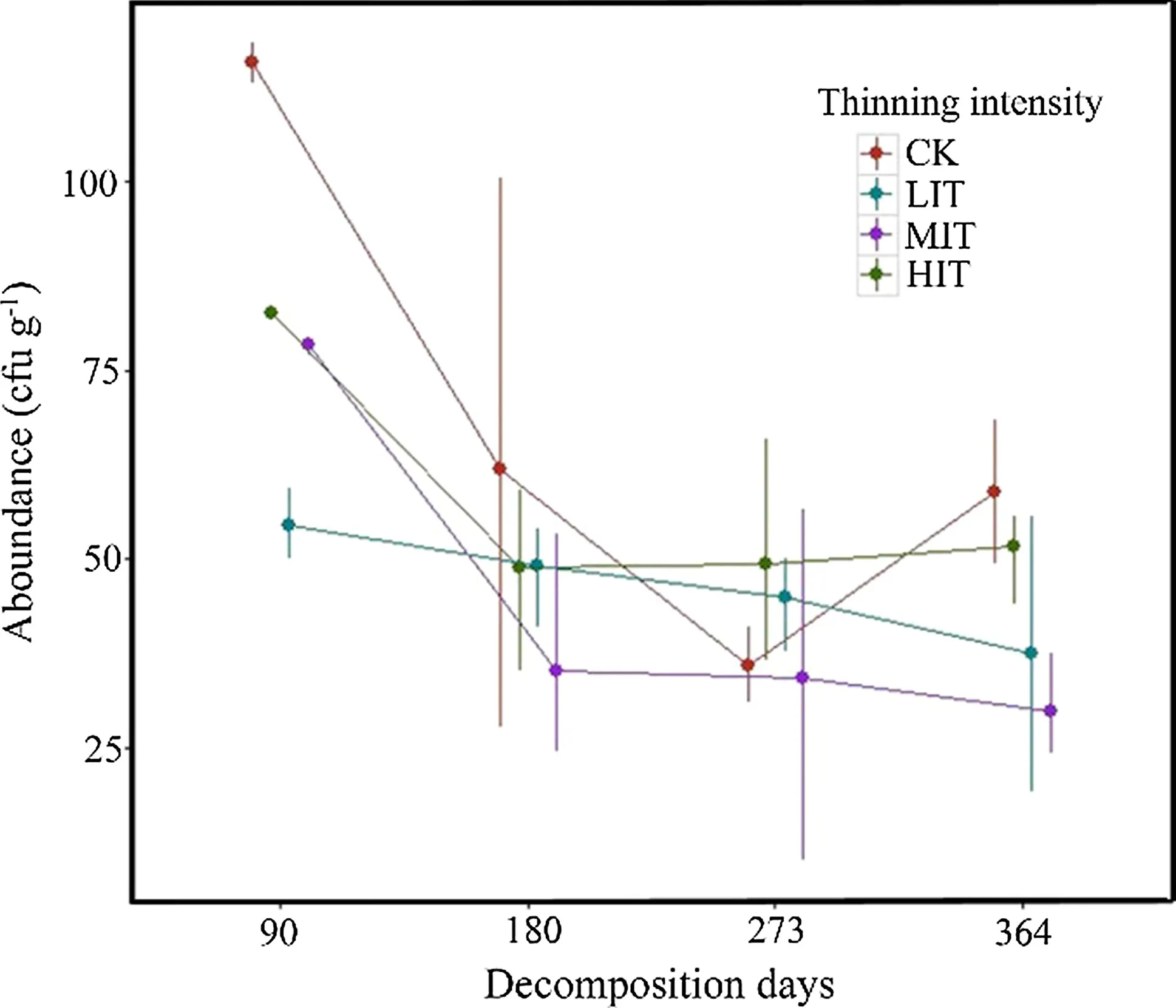
Fig.2 Effects of thinning intensity on total abundance during litter decomposition in samples collected from March 2013 to December 2013 across the four treatments(bars indicate SE;n=3).(CK,control plots;LIT,low-intensity thinning;MIT,medium-intensity thinning;HIT,high-intensity thinning).Values are means±95%bootstrapped confidence intervals
Our results suggest that although microbial abundance decreased in the litter following thinning,thinning maintained the abundance of microbial species that utilize different carbon sources in litter,indicating that the diversity index of the microorganism had not changed,but the species present were altered.The higher litter production in the un-thinned plots leads to a higher carbon content in litter,which would cause fungi to become dominant(Roig et al.2005;Blanco et al.2006;Floudas et al.2012).Lower amounts of organic C and a lower C/N ratio may result in competition for microbial resources and stimulate microbial species to maximize and enhance microbial functional richness(Chen et al.2015).Thinning increased the content of plant-available nutrients and altered under story plant diversity,leading to changes in forest litter biomass and structure.Such changes would result in differences in carbon sources utilization by microbial species during litter decomposition.

Fig.3 Litter microbial functional diversity(AWCD,average well color development;H′,Shannon diversity index;J′,Pielou’s evenness index)in relation to thinning intensity.CK,control plots;LIT,low intensity thinning;MIT,medium-intensity thinning;HIT,high intensity thinning during litter decomposition.Values are means±95%bootstrapped confidence intervals
The total abundance of microorganisms and the types of carbon sources utilized by these species during litter decomposition showed positive effects of the thinning intensity,with these parameters exhibiting significant deviation from control plots under all thinning intensities.These findings are consistent with previous work indicating that the overall pattern regarding the number and distribution of species in the community are significantly influenced by thinning treatment(Cookson et al.2008).
The types of under story vegetation present after thinning increased significantly,affecting the number of plant species contributing to the litter and altering microbial communities(Staddon et al.1997;Bowman et al.2004;Shi et al.2011).These increases can provide a variety of carbon sources and nutrients for microorganisms(Mungai et al.2005;Zhong and Cai 2007;Ushio et al.2010).The increase in the number of plant species in response to thinning would produce a more diverse litter fall,leading to species maximization in the microbial community(Zak et al.2003;Bartelt-Ryser et al.2005;Liao et al.2006).
Correlation analysis revealed that the differences in microbial total abundance among the different thinning treatments were primarily influenced by variations in the C concentration and C/N ratio in litter.This relationshipbetween microbes and litter chemical characteristics is consistent with the results of other studies(Matulich and Martiny 2014).The microbial community is closely related to litter decomposition but is also affected by the quality and chemistry of organic matter in litter(Trinder et al.2009;Cleveland et al.2014;Matulich and Martiny 2014;Creamer et al.2015;Fernandez et al.2015).
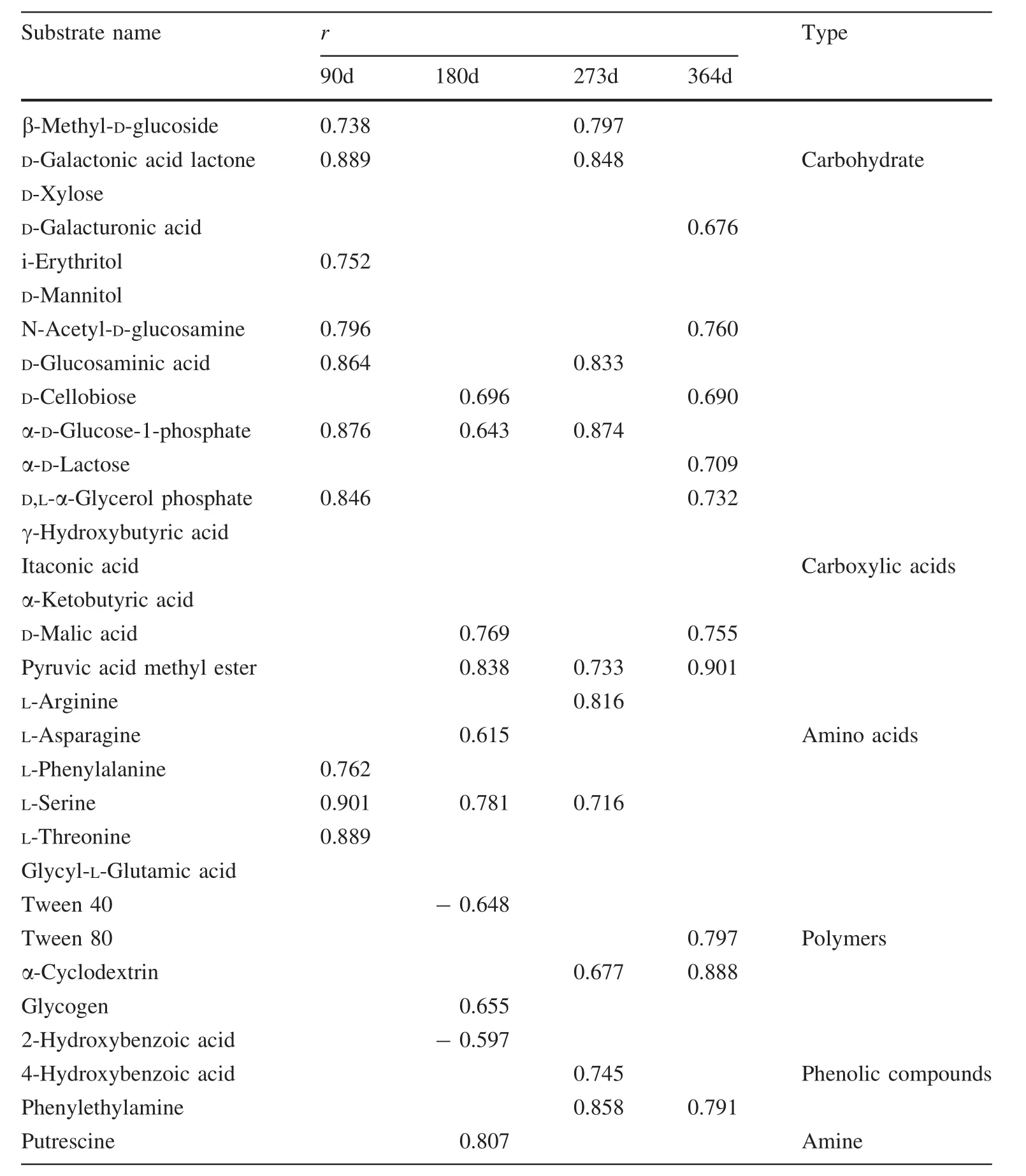
Table 2 Substrates with significant Pearson correlation coefficients with PC1 in the PCA of 31 kinds of carbon sources utilization patterns of the microbial community in the litter decomposition of 90d,180d,273d,364d on ECO plates
The microbial community is restricted by the carbon sources made available through litter decomposition,mainly being affected by nutrients and recalcitrant materials,such as cellulose and lignin(McClaugherty and Berg 1987).This pattern may reflect the N usage of microorganisms,which becomes stable after the decomposition period,such that microbial nutrients can be sustained,and microorganism growth is no longer restricted(Aber 1992;Kaye and Hart 1997).Therefore,the decomposition of labile material occurs rapidly at first,and the remaining recalcitrant materials then become the limiting condition of microbial decomposition.
Microbial physiological groups that utilize specific nutritional resources are restricted by the quality of the available resources,which are controlled by the plant species present(Wardle et al.2004;Zhong and Cai 2007).During the process of litter decomposition,the concentration of N,lignin/N,and C/N in litter strongly contribute to the variation of microbial activity in litter(Torres et al.2005;Smolander et al.2008;Kunhamu et al.2009;Matulich and Martiny 2014).Variations in the C/N ratio has been found to restrict microorganism activities,resulting in variation of the litter decomposition rate,thereby promoting nutrient cycling and material flow in forest ecosystems(Aber 1992;Kaye and Hart 1997).
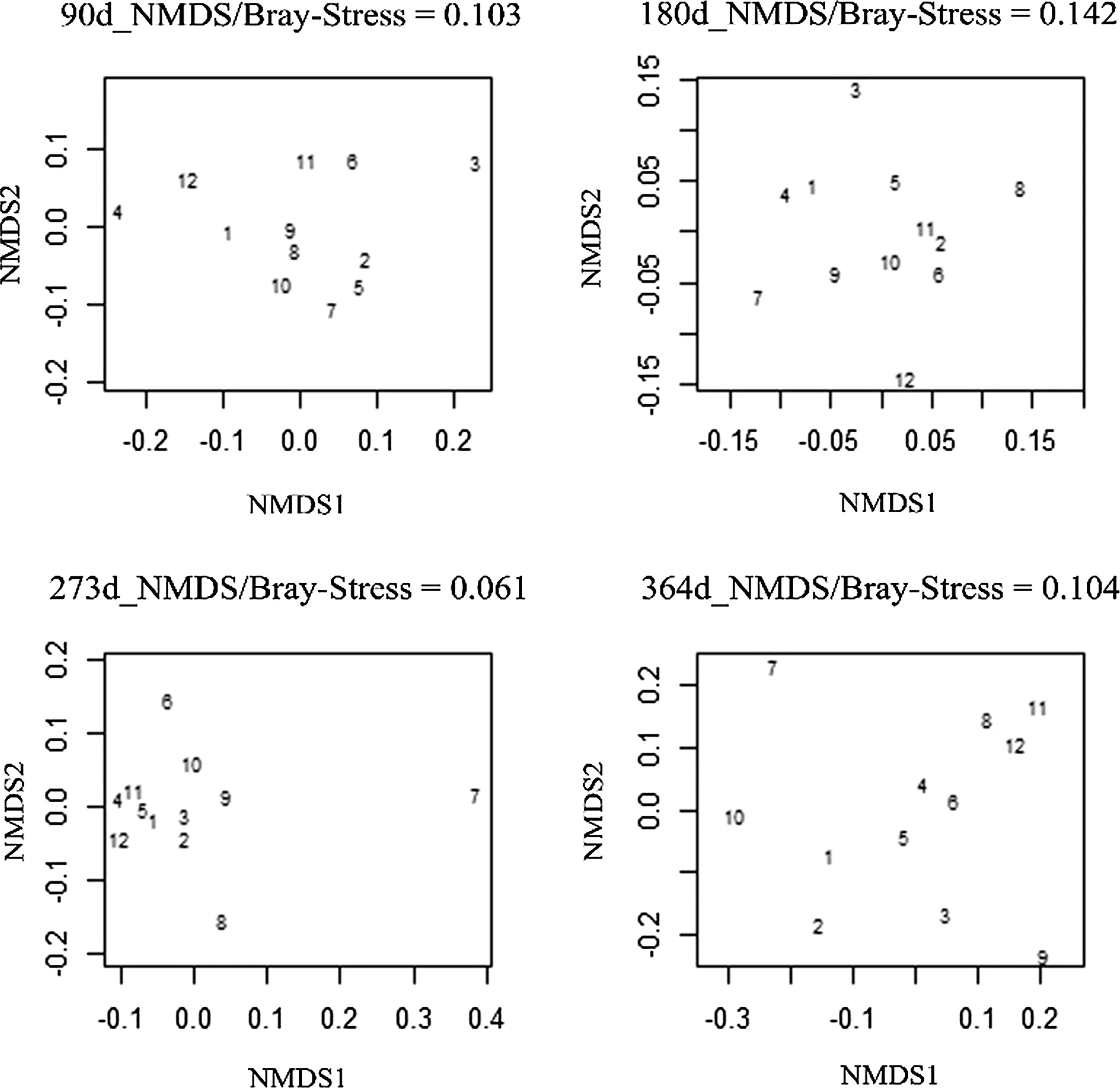
Fig.4 Analysis of different thinning intensities(1,2,3-control plots,4,5,6-low intensity thinning,7,8,9-medium-intensity thinning,and 10,11,12-high-intensity thinning):NMDS of carbon sources utilization patterns of the microbial community during the litter decomposition
Microbial enzymatic activities
Microbial cellulase and invertase activities during litter decomposition differed with the thinning intensity,due to changes in the litter C concentration,C/N,and lignin/N.Compared with their abundance in the control plots,understory vegetation species were relatively more abundant under the different thinning treatments,and large differences in the community composition were observed.These influences could lead to the variation in microbial cellulase and invertase activities observed under the thinning treatments in the present study.Therefore,the complex interactions among litter properties—such as substrate availability,nutrient content,and the litter composition and quality—could be primary factors that affect microbial enzymatic activities in decomposing litter fall.
Decomposition and the thinning treatments had an interactive effect on microbial enzymatic activities.The responses of microbial enzymatic activities to the thinning treatments differed with the period of decomposition.Contrasting results were previously observed in soil from the New Jersey Pine Barrens,where cellulase activity decreased significantly after thinning(Geng et al.2012).Microbial biomass and extracellular enzyme activities involved in litter decomposition have also been reported to decrease with the aspen harvest intensity(Hassett and Zak 2005).However,the activities of cellulase and phosphatases have been found to be significantly higher in litter,and a significant correlation between the cellulose concentration and cellulase levels has been reported(Andersson et al.2004;Alarcón-Gutiérrez et al.2009).The proportions of the number of fungi and bacteria would simultaneously stimulate the production of microbial enzymes,thus also affecting enzyme activity after thinning(Geng et al.2012).
Previous studies have shown that the soil C/N ratio increases modestly after mechanical thinning,but without any statistically significant effect on phosphatase activity(Boerner et al.2008).These observations are consistent with our findings.Cumulative enzyme activities were more closely related to decomposition rates,and the microbial degradation of litter was therefore more efficient in plots that were thinned than in the other plots(Rietl and Jackson 2012).Temperature and water content were also among the main factors negatively affecting the activity of microbial enzymes after thinning(Mosca et al.2007).Therefore,high-intensity thinning,associated with greater solar penetration,increased the efficiency of litter decomposition,
coupled with the promotion of cumulative enzyme activity,because of increased water-evaporation losses.

Fig.5 Enzymatic activities during litter decomposition in relation to thinning intensity(CK,control plots;LIT,low intensity thinning;MIT,medium-intensity thinning;HIT,high-intensity thinning).Units for all activities are mg g-1h-1.Values are means±95%bootstrapped confidence intervals

Table 3 Pearson liner correlation matrixes(r-values)of microbiological characteristics and environmental factors under different thinning intensities and control plots
In different stages of decomposition,changes in litter quality alter the catalytic activity of the enzymes,leading to changes in the expression levels of different enzymes(Fioretto et al.2007).In the early stage of litter decomposition,it could be seen that cellulase and invertase activities were significantly enhanced by the thinning intensity be causepoly saccharides,such as cellulose,mainly require decomposition by cellulase and invertase.This finding may be related to the high C/N ratio and lignin concentration of Chinese fir litter fall(Yang et al.2005),whose decomposition may therefore be limited by a lack of inorganic N(Keeler et al.2008),resulting in a burst of urease activity during the litter decomposition process.In contrast,phosphatase activity is primarily controlled by environmental factors,including temperature,moisture,and N availability(Boerner et al.2008).Enzymes preferentially utilize readily biodegradable substances to maintain microorganism growth and reproduction in litter and soil(Herman et al.2008),which are restricted by the litter chemistry during litter decomposition.
Litter chemistry and site characteristics are strong determinants of enzyme activity in decomposing litter(Kourtev et al.2002),as observed in the present study,where most of the evaluated microbial enzymatic activities exhibited that significantly correlated with the C concentration,C/N,and lignin/N during litter decomposition.These findings are consistent with results showing that cellulase activity is significantly and positively related to the C/N ratio,which is determined by substrate-induced respiration in beech litter(Andersson et al.2004).
Several studies have shown that the N concentration has a direct effect on microbes by increasing cellulose activity in decaying leaf litter(Andersson et al.2004;Keeler et al.2008).In the present study,thinning had a significant effect on the litter N concentration,which would directly affect the activity of microorganisms.The different layer-specific responses of enzyme activities to changes in N availability indicate different impacts of N availability on litter decomposition.Invertase,cellulase,and urease activities are primarily responsible for litter decomposition in coniferous forests and are significantly correlated with widespread loss(Wang et al.2010).Enzyme activities and decomposition rate constants both vary significantly by litter type(Adamczyk et al.2014).
Litter decays more rapidly due to increases in carbondegrading enzyme activities,while reduced litter decomposition is caused by decreased enzymatic activities(Saiya-Cork et al.2002;Allison and Vitousek 2004;Wang et al.2010;Lv et al.2014).The extracellular enzyme responses of a forest- floor microbial community can explain both increased and decreased litter decomposition rates(Andersson et al.2004;Keeler et al.2008).Therefore,the amount of forest litter fall,vegetation diversity,and microbial community changes would affect the responses of enzyme activities to the thinning intensity,ultimately leading to differences in the rate of litter decomposition.
Conclusions
The thinning treatments applied in the present study decreased total microbial abundance and altered microbial carbon source utilization.Microbial enzymatic activities showed strong,significant correlations with litter chemistry during litter decomposition.In particular,cellulase and invertase activities significantly responded to thinning.These results suggest that thinning has a negative effect on microbial abundance but can enhance microbial activities to accelerate litter decomposition.Moreover,high-intensity thinning often results in significantly higher enzymatic activities than were observed in the control and lower-intensity thinned plots,indicating that the 70%thinning intensity treatment improved microbial function to the greatest extent,followed by the 30%thinning intensity treatment.
Furthermore,the changes in microbial functions were mainly caused by changes in the carbon content and the C/N ratio in litter.Moderate-intensity thinning may maximize vegetation diversity,making numerous sources of materials available for microbial organisms in litter,thereby promoting nutrient cycling and material flow in forest ecosystems.The 70%thinning intensity treatment significantly altered microbial functional activities.These findings provide insights into the effects of thinning treatments on microbial-specific mechanisms in ecosystem restoration in the subtropical region of China.
AcknowledgementsWe appreciate this financial support.The authors also thank our colleagues and the farmers of the Lishui Tree Farm for their assistance.
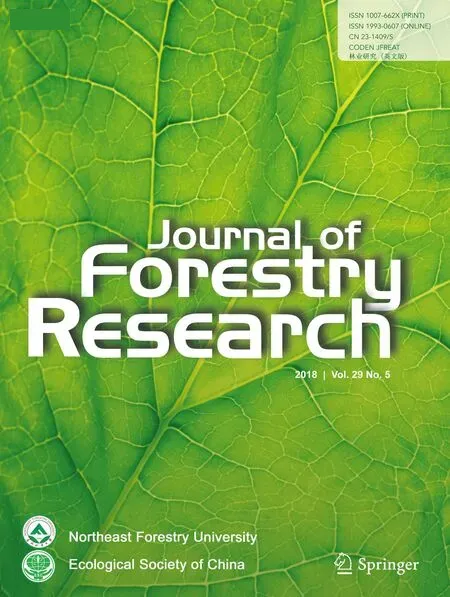 Journal of Forestry Research2018年5期
Journal of Forestry Research2018年5期
- Journal of Forestry Research的其它文章
- Environmental load of solid wood floor production from larch grown at different planting densities based on a life cycle assessment
- Variability in physical properties of plantation-grown progenies of Melia composita and determination of a kiln-drying schedule
- Optimization of CNC cutting parameters using design of experiment(DOE)and desirability function
- Reduction of electric field strength by two species of trees under power transmission lines
- Forest type identification by random forest classification combined with SPOT and multitemporal SAR data
- Forest mapping:a comparison between hyperspectral and multispectral images and technologies
